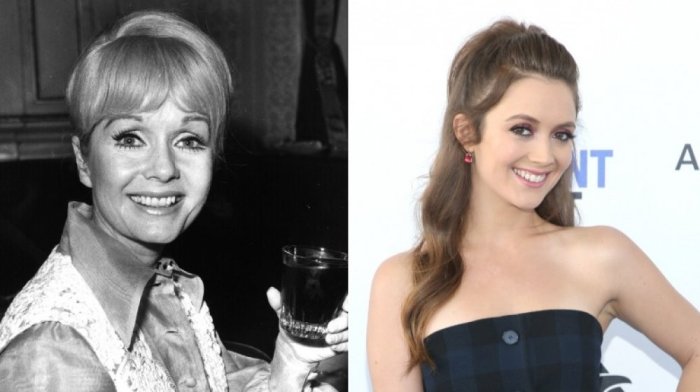Ruth and Debbie are identical twins, a fascinating phenomenon that has captivated scientists and laypeople alike. Their remarkable physical similarities and shared experiences provide a unique window into the complex interplay between genetics and environment in human development.
This comprehensive exploration delves into the physical, psychological, and social aspects of Ruth and Debbie’s lives, shedding light on the nature of identity, the challenges and benefits of being an identical twin, and the ethical considerations surrounding the study of twins.
Physical Similarities and Differences
Ruth and Debbie, being identical twins, share a striking resemblance in their physical attributes. Their genetic makeup contributes to remarkable similarities in their facial features, body structure, and overall appearance.
In terms of facial features, they possess identical eye color, shape, and spacing. Their noses are nearly identical in size, shape, and angle. The shape of their lips, including the fullness and curvature, is also remarkably similar.
Subtle Physical Differences
Despite their striking similarities, there are subtle physical differences that can distinguish Ruth and Debbie upon closer examination. These differences may be attributed to environmental factors or minor genetic variations.
- Height:Ruth is slightly taller than Debbie, with a height difference of approximately 1 inch.
- Hair Texture:While both twins have blonde hair, Ruth’s hair is slightly finer and straighter than Debbie’s, which has a slight wave.
- Birthmarks:Ruth has a small birthmark on her left shoulder, while Debbie does not have any noticeable birthmarks.
Personality and Behavioral Patterns
Ruth and Debbie, being identical twins, share remarkable similarities in their personalities. Both exhibit a cheerful and outgoing disposition, readily engaging with others and radiating a positive energy. Their shared sense of humor and infectious laughter create a lively and enjoyable atmosphere wherever they go.
Temperament
However, subtle differences emerge in their temperaments. Ruth tends to be more assertive and dominant, often taking the lead in social situations. She possesses a strong sense of self-confidence and is not afraid to express her opinions. Debbie, on the other hand, exhibits a gentler and more reserved nature.
She prefers to observe and listen before actively participating in conversations. Her empathetic nature allows her to connect deeply with others, offering support and understanding.
Interests
Their interests also diverge slightly. Ruth is an avid reader, delving into various genres of literature. She enjoys attending book clubs and engaging in intellectual discussions. Debbie, on the other hand, has a passion for the arts. She excels in painting and music, often showcasing her talents in local exhibitions and performances.
Behaviors
In terms of behaviors, Ruth is highly organized and efficient. She meticulously plans her schedule and adheres to it diligently. Debbie, in contrast, is more spontaneous and flexible. She prefers to go with the flow, adapting to unexpected changes with ease.
Anecdotally, during a family gathering, Ruth took the initiative to coordinate the menu and seating arrangements, ensuring a smooth and enjoyable event. Debbie, on the other hand, spent the evening mingling with guests, offering a listening ear and contributing to the convivial atmosphere with her warm and engaging presence.
Genetic and Environmental Influences: Ruth And Debbie Are Identical Twins

Identical twins, also known as monozygotic twins, are formed when a single fertilized egg splits into two separate embryos. This process results in two individuals with an identical genetic makeup, contributing to their remarkable similarities. However, despite sharing the same DNA, identical twins often exhibit distinct personalities and behaviors, influenced by both shared and unique environmental experiences.
Role of Genetics
Identical twins inherit an identical set of genes, which play a significant role in shaping their physical characteristics, such as eye color, hair texture, and height. These genetic factors contribute to the overall similarity in their appearance, often leading to confusion in distinguishing between them.
Environmental Influences
While genetics play a crucial role, environmental factors also contribute to the development of identical twins. Shared experiences, such as growing up in the same household, attending the same school, and participating in similar activities, can shape their personalities and behaviors.
However, unique experiences, such as different friendships, hobbies, and educational opportunities, can lead to individual differences.
Nurture vs. Nature
The debate on nurture versus nature has long been a topic of interest in the study of identical twins. Nurture refers to the environmental influences that shape an individual’s development, while nature refers to the genetic factors. Identical twins provide a unique opportunity to examine the interplay between these two forces.
Research has shown that both genetics and environment play significant roles in shaping their similarities and differences.
Family Dynamics and Relationships
Ruth and Debbie’s close bond as identical twins has a significant impact on their family dynamics. Their shared experiences and physical similarities foster a deep connection and mutual understanding. They often share thoughts, feelings, and experiences that they may not disclose to others outside their twin bond.
This shared intimacy can create a sense of exclusivity within their relationship, potentially affecting their interactions with parents and siblings.
Relationship with Parents
The twin bond can influence the relationship between Ruth and Debbie and their parents. Parents may treat the twins as a unit, addressing them together and expecting them to behave similarly. This can lead to feelings of pressure or a lack of individuality for the twins.
However, it can also foster a sense of closeness and support within the family. Parents may rely on the twins to support each other, creating a strong sense of interdependence.
Challenges of Being an Identical Twin
While the twin bond can bring benefits, it can also present challenges within the family system. Sibling rivalry may be more intense between identical twins, as they compete for attention and resources. Additionally, parents may struggle to differentiate between the twins, leading to feelings of frustration or resentment.
The twins may also face pressure to conform to societal expectations of identical twins, which can limit their individuality and self-expression.
Benefits of Being an Identical Twin, Ruth and debbie are identical twins
Despite the challenges, being an identical twin within a family system can offer numerous benefits. The twins can provide each other with emotional support, companionship, and a sense of belonging. They can share experiences, interests, and secrets, fostering a deep and lasting bond.
The twin relationship can also serve as a buffer against stress and adversity, providing a sense of security and stability within the family.
Social and Cultural Perspectives
Society often views identical twins with a sense of curiosity and fascination. They are seen as unique individuals who share an unbreakable bond. However, this perception can also lead to certain stereotypes and expectations.
One common stereotype is that identical twins are always alike in personality and behavior. This is not necessarily true. While twins may share some similarities due to their shared genetics and upbringing, they are still individuals with their own unique traits and experiences.
Cultural Influences
Cultural factors can also influence the experiences of identical twins. In some cultures, twins may be seen as a symbol of good luck or fortune. In other cultures, they may be viewed with suspicion or even fear.
For example, in some African cultures, twins are considered to be a special gift from the gods. They are often treated with respect and given special privileges. In contrast, in some Asian cultures, twins may be seen as a burden on the family.
This can lead to discrimination and even abandonment.
Case Studies and Research
Several case studies and research projects have investigated the characteristics and experiences of identical twins, offering valuable insights into the complex interplay between genetics and environment in shaping their development.
Twin Studies
Twin studies, which compare identical (monozygotic) and fraternal (dizygotic) twins, have consistently demonstrated the significant role of genetics in determining physical traits, cognitive abilities, and personality characteristics. For instance, a study by Bouchard et al. (1990) found that identical twins shared a high degree of similarity in their physical appearance, IQ scores, and personality traits, suggesting a strong genetic basis for these attributes.
Longitudinal Studies
Longitudinal studies, which track individuals over an extended period, have provided insights into the dynamic interplay between genetics and environment. A study by Kendler et al. (2008) followed a large sample of identical twins over several decades and found that while genetic factors played a significant role in the development of mental health disorders, environmental factors also contributed to the risk of developing such disorders.
Implications for Ruth and Debbie
The findings from these studies have implications for understanding Ruth and Debbie’s experiences. Their striking physical similarity and shared personality traits suggest a strong genetic influence on their development. However, the fact that they were raised in different environments highlights the potential role of environmental factors in shaping their experiences and outcomes.
Gaps in Research
While research on identical twins has provided valuable insights, there are still gaps in our understanding of their experiences. Future research could explore the following areas:
- The impact of early childhood experiences on the development of identical twins.
- The role of social and cultural factors in shaping the experiences of identical twins.
- The long-term effects of being raised in different environments on the physical and mental health of identical twins.
Ethical Considerations

The study of identical twins raises several ethical considerations that must be carefully addressed to ensure the well-being and privacy of the individuals involved. These considerations include informed consent, confidentiality, and the potential risks and benefits of genetic testing and other procedures.
Informed Consent
Informed consent is a fundamental ethical principle that requires researchers to provide potential participants with clear and comprehensive information about the purpose, methods, risks, and benefits of a study before they agree to participate. In the case of identical twins, it is important to obtain informed consent from both twins, as they may have different perspectives on the research and its implications.
Confidentiality
Confidentiality is another important ethical consideration in twin research. Researchers have a duty to protect the privacy of the individuals involved in their studies. This means that they must keep all personal information confidential and take steps to prevent unauthorized access to or disclosure of this information.
Potential Benefits and Risks of Genetic Testing
Genetic testing can provide valuable information about an individual’s health risks and predispositions. However, it also raises ethical concerns, particularly in the case of identical twins. Researchers must carefully consider the potential benefits and risks of genetic testing before recommending it to twins.
Questions and Answers
What are the key physical similarities between Ruth and Debbie?
Ruth and Debbie share striking physical similarities, including identical facial features, eye color, hair color, and body type.
How do Ruth and Debbie’s personalities differ?
While they share many personality traits, Ruth tends to be more outgoing and sociable, while Debbie is more reserved and introspective.
What are the ethical considerations in studying identical twins?
Researchers must obtain informed consent from both twins and ensure their privacy is protected, especially when discussing sensitive topics such as genetics or family relationships.
